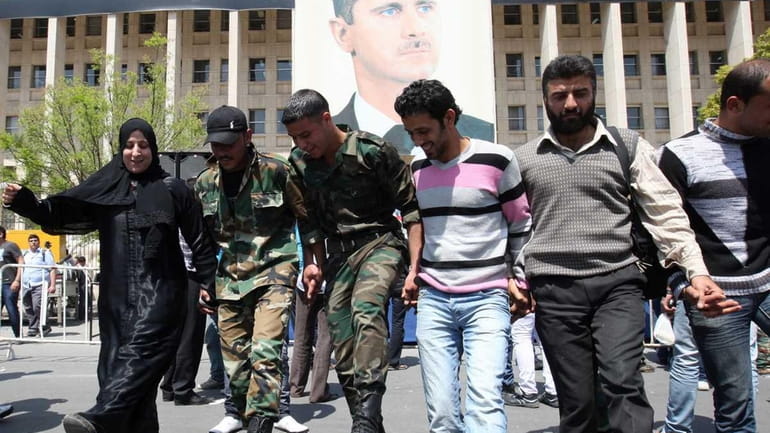Activists: Dozens killed in Syria after UN visit

A Syrian woman dances with men in army fatigues in front of a portrait of Syrian President Bashar Al-Assad during a pro-regime rally in Damascus, as a UN-backed ceasefire went into effect. Forces loyal to Syrian President Bashar al-Assad shot dead a civilian in the central province of Hama, a monitoring group said, hours after a deadline to implement a ceasefire aimed to end 13 months of bloodshed. (April 12, 2012) Credit: Getty Images
Syrian troops armed with heavy machine guns killed dozens in the central city of Hama Monday, activists said, just a day after chanting protesters welcomed a visit by a U.N. team sent to observe a shaky cease-fire.
The day's violence, the city's worst in months, added a dangerous new aspect to the U.N. team's work: that the Syrian regime might exact deadly revenge against opponents who feel empowered by the observers' presence to spill into the streets.
Observance of the truce, which was supposed to begin April 12, has been spotty at best. The main manifestation has been a temporary halt to fighting between President Bashar Assad's troops and rebel forces in locations where observers are present.
Skepticism about the cease-fire remains high, but world leaders say the current plan to stop more than a year of hostilities might be the last chance.
The U.N's political chief B. Lynn Pascoe told the Security Council that the Syrian government is still using heavy weapons and has failed to implement the peace plan brokered by former Secretary General Kofi Annan.
Pascoe said Syria's compliance with other elements of the plan, like releasing detainees and allowing peaceful demonstrations, is "clearly insufficient."
Some details of Monday's events in Hama remained murky, though different activists said the attacks started early in the morning and stopped a few hours later after dozens of people had been killed.
Rami Abdul-Rahman, the head of the Britain-based Syrian Observatory for Human Rights, said troops stormed the town, firing assault rifles and heavy machine guns, killing at least 33 people.
An activist named Ahmed reached by phone in Hama said troops shelled the Arbeen district early Monday before sending in foot soldiers. He said 27 people were killed, and families were still searching damaged homes for others. He did not give his full name for fear of retribution.
Another activist in Hama, Mousab Alhamadee, reached via Skype, said as many as 50 had been killed. He guessed the attack was a direct result of the U.N. monitor's visit Monday.
"This was the punishment for the people of Hama because yesterday they were very brave when they met the U.N. monitors," he said.
The U.N. has sent an advance team of eight observers to Syria as part of international envoy Kofi Annan's plan to end the fighting. More monitors are due to arrive in the coming days, and the U.N. has authorized a mission of 300 total observers, though it remains unclear when the full contingent will deploy.
Many Syrians, as well as the Western powers, have voiced skepticism about Assad's willingness to abide by the plan for ending the bloodshed and launching talks between the regime and the opposition. They say the Syrian leader is largely paying lip service to the truce, since full compliance — including withdrawing troops and heavy weapons from populated areas and allowing peaceful demonstrations — could quickly sweep him from power.
Since the cease-fire went into effect, regime forces have continued to shell rebellious areas, and rebels have attacked regime checkpoints and military convoys.
The uprising against Assad began in March 2011 with largely peaceful protests calling for his ouster. The regime responded with a withering crackdown, which prompted many in the opposition to take up arms to fight government troops.
The Syrian state news agency said Monday that "terrorists" killed a doctor in the country's south, two military officers in the central province of Hama and two others in the south.
The Syrian government blames the uprising on terrorists acting out a foreign conspiracy.
The international community has increasingly used sanctions in an attempt to bring the Assad government to heel.
In Washington, President Barack Obama announced new sanctions on people and entities in Iran and Syria that use technology to target citizens and erode their human rights. Iran has provided Assad's regime with technology to jam cell phones and block or monitor social networking sites used to organize demonstrations.
"National sovereignty is never a license to slaughter your people," he said.
In Luxembourg Monday, the European Union passed its 14th set of sanctions against Syria, this time banning "luxury goods" and products that can be used against protesters.
EU experts will work out later precisely which goods will be listed in the embargo. A diplomat said they could include anything from vehicles to fertilizers and other chemicals.
The only precedent for the luxury ban is one imposed by the E.U. in 2007 on North Korea for its nuclear and ballistic missile programs, which included caviar and truffles, high-quality wines and spirits, fashion accessories, perfumes and purebred horses.
Officials said this could serve as a model for the same measures against Syria. Such a ban aims at the wealthy business class that has largely stood by Assad.
"We need to continue to intensify pressure on the Assad regime," British Foreign Secretary William Hague said. "They are not in complete compliance with the cease-fire provisions of the Annan plan."
Updated 22 minutes ago Gilgo Manorville search ... Southold hotel pause ... Home sales ... What's up on Long Island
Updated 22 minutes ago Gilgo Manorville search ... Southold hotel pause ... Home sales ... What's up on Long Island
